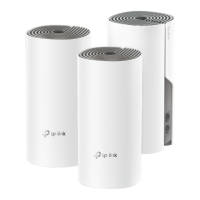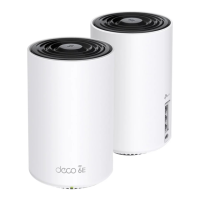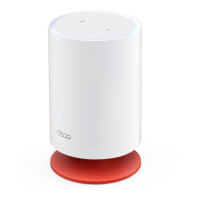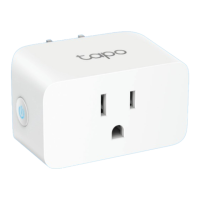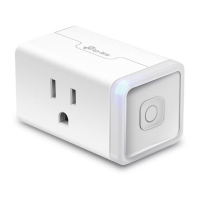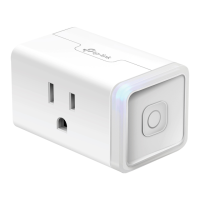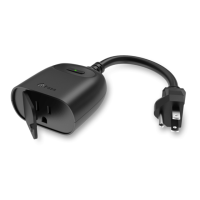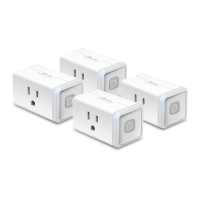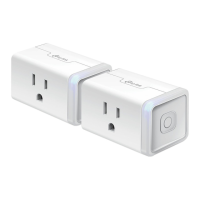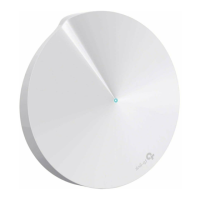
Do you have a question about the TP-Link Deco M9 Plus and is the answer not in the manual?
| Ethernet LAN | Yes |
|---|---|
| Product color | White |
| WAN connection | Ethernet (RJ-45) |
| Wi-Fi standards | 802.11a, Wi-Fi 5 (802.11ac), 802.11b, 802.11g, Wi-Fi 4 (802.11n) |
| Antennas quantity | 8 |
| Cabling technology | 10/100/1000Base-T(X) |
| Ethernet LAN data rates | 10, 100, 1000 Mbit/s |
| WLAN data transfer rates supported | 400, 867 Mbit/s |
| Memory card slot(s) | No |
| USB 2.0 ports quantity | 1 |
| Ethernet LAN (RJ-45) ports | 2 |
| Networking standards | IEEE 802.11a, IEEE 802.11ac, IEEE 802.11b, IEEE 802.11g, IEEE 802.11n, IEEE 802.3, IEEE 802.3ab, IEEE 802.3u |
| Ethernet LAN interface type | Gigabit Ethernet |
| Wi-Fi band | Tri-band (2.4 GHz / 5 GHz / 5 GHz) |
| Top Wi-Fi standard | Wi-Fi 5 (802.11ac) |
| Security algorithms | WPA-PSK, WPA2-PSK |
| WLAN data transfer rate (max) | 2134 Mbit/s |
| WLAN data transfer rate (first band) | 400 Mbit/s |
| WLAN data transfer rate (second band) | 867 Mbit/s |
| Transmit power | FCC: \u003C30 dBm, CE: \u003C20 dBm (2.4 GHz), \u003C23 dBm (5 GHz) dBmW |
| Product type | Tabletop router |
| Certification | FCC CE |
| LED indicators | Power |
| Storage temperature (T-T) | -40 - 70 °C |
| Operating temperature (T-T) | 0 - 40 °C |
| Storage relative humidity (H-H) | 5 - 90 % |
| Operating relative humidity (H-H) | 10 - 90 % |
| Firewall security | SPI |
| Bluetooth version | 4.2 |
| Mobile operating systems supported | Android 4.4, Android 5.0, Android 5.1, Android 6.0, Android 7.0, Android 7.1, Android 7.1.2, Android 8.0, Android 9.0, iOS 10.0, iOS 11.0, iOS 11.4, iOS 12, iOS 13, iOS 9.0, iOS 9.1, iOS 9.2, iOS 9.3 |
| Supported network protocols | IPv4 / IPv6 |
| Cables included | LAN (RJ-45) |
| Number of products included | 3 pc(s) |
| Output current | 2 A |
| Output voltage | 12 V |
| AC input voltage | 100 - 240 V |
| Power source type | AC |
| AC input frequency | 50 - 60 Hz |
| AC adapter input current | 0.8 A |
| Width | 144 mm |
|---|---|
| Height | 64 mm |
| Package depth | 276.5 mm |
| Package width | 369 mm |
| Package height | 110 mm |
| Package weight | 2500 g |
Explains text and icon conventions used throughout the guide.
Disclaimer regarding actual wireless transmission rates, coverage, and device quantity.
Details the features and duration of the included HomeCare package.
Clarifies the scope of IoT compatibility with the Deco app.
Notes client requirements and performance variations for seamless roaming.
Explains the meaning of different LED colors on the Deco unit.
Describes the physical Ethernet ports, reset button, and power slot.
Guide to obtaining and installing the Deco mobile application.
Instructions for creating or logging into a TP-Link account.
Steps to select the correct Deco model during initial setup.
Procedures for physically connecting the Deco to your modem.
Assigning a specific location to the Deco unit within your home.
Setting up the internet connection type and parameters.
Steps to define the Wi-Fi network name and password.
Confirmation of the initial Deco network setup process.
Guide to adding additional Deco units to expand the network.
How to locate and confirm newly added Deco units in the app.
Accessing the main dashboard for network status.
Functionality for creating and running quick actions.
Setting up automations to link smart device behaviors.
Navigating to the 'More' section for additional settings.
Monitoring the online and operational status of all Decos.
Viewing specific information and statistics for each Deco.
Changing or updating the assigned location for a Deco unit.
Accessing detailed information for connected clients.
Modifying settings and profiles for connected devices.
Adding unique profiles for devices to manage online activities.
Steps to create a new network via the app's main screen.
Steps to create a new network using the app's menu.
Instructions on how to remove or restart a Deco unit from the app.
Guide to defining custom shortcuts for actions.
Performing a shortcut action with a single tap.
How to modify previously created shortcuts.
Scheduling when an automation is active and how often.
Specifying conditions that initiate an automation.
Defining the tasks an automation will perform.
Finalizing the automation setup by naming and saving it.
Changing the primary Wi-Fi network name and password.
Setting up a separate Wi-Fi network for guests.
Using the feature to easily share Wi-Fi credentials.
Initiating a test to measure internet download and upload speeds.
Examining the report generated after the speed test.
Accessing past results of internet speed tests.
The app automatically scans the network for performance improvements.
Steps to ensure optimal Wi-Fi performance by optimizing channels.
Blocking specific devices from accessing the network.
Adding devices to the blacklist using their MAC addresses.
Reviewing and removing devices from the blacklist.
Instructions for updating the Deco system to the latest firmware version.
Using WPS for quick and secure connection of clients to the network.
Setting up individual profiles for family members to manage access.
Filtering inappropriate content based on age or category.
Limiting the amount of time devices can be used daily.
Activating and configuring the Deco's antivirus capabilities.
Specifying websites that should not be blocked by the antivirus.
Configuring the total available bandwidth for the network.
Assigning priority to specific applications or devices for better performance.
Reviewing daily network activity, security threats, and device counts.
Enabling or disabling the creation of monthly usage reports.
Deleting historical monthly usage data from the system.
Inviting friends or family to help manage the network.
Setting specific permissions for each network manager.
Deleting a user from the network management team.
Settings for IPv4, IPv6, and internet connection types.
Modifying LAN IP addresses and DHCP server configuration.
Features like IPv6 firewall, port forwarding, and MAC clone.
UPnP, Fast Roaming, and Beamforming for network performance.
Changing operating modes, LED control, and notification settings.
Regulatory information regarding FCC standards and testing.
Details on compliance with radio frequency exposure limits.
Regulatory compliance information for Industry Canada.
Statement of compliance with EU directives and requirements.
General safety guidelines for using the device.
Descriptions of symbols found on the product label.
Guidance on responsible disposal and recycling of the product.
